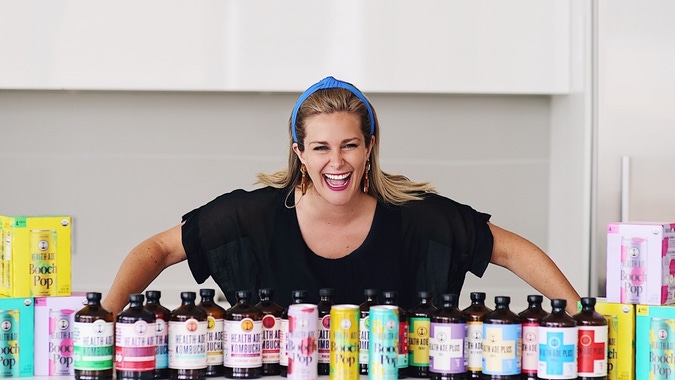
Articles
How To Sell A Compelling Brand Story
November 8, 2021

Building your business is hard enough. And when you have the added pressure of standing out from the competition, the task becomes even more challenging. But there is a way to separate yourself from competitors: a compelling brand story.
Every business has an origin story. Where you started, how you made your first sale, why you had to bring your product with the world - your business’s beginnings become a story to share.
But the narrative doesn’t stop there! As you continue growing your business, you need to define your values and place in the industry. And your brand story becomes a huge factor in how consumers think about your business. Especially in comparison to your business rivals.
At Playbook 2021, our second annual small business conference, we spoke with leaders from Health-Ade Kombucha and Cocokind, two of today’s most engaging companies.
There, they shared their humble beginnings and how they’ve built their companies’ narratives over the years. In the process, they shared insights into defining your company’s story and distinguishing your brand.
👉 Want to watch the rest of the Playbook 2021 sessions? Register for the free replay!
Define your values early
Your core values are the guiding principles that your business lives by. These values help create alignment amongst your employees and define how you create and reach your goals.
They even determine your customer base. That’s because 63% of consumers prefer to buy from companies that share their personal values.
For Daina Trout, co-founder of Health-Ade Kombucha, establishing the company values early was necessary for their growth. Founded in 2012, the company currently sells its products in over 45,000 stores and makes over $200M in sales annually.
She had previously worked as a change agent at a pharmaceutical company to improve engagement for employees. There, she learned that a good employee culture streamlines company growth - and a good culture can only come from a deliberate set of values.
“[Your values] have to really embody the culture,” Daina explained. “We were very deliberate about [setting our values] from the beginning.”
When Health-Ade started, the original goal was to produce hair loss treatment using a kombucha by-product, bacteria SCOBY. But when their first farmer’s market came around, the business had no finalized product to sell. So, they sold their kombucha instead. And they’ve never looked back.
In those early days, the Health-Ade team chose grit, optimism, authenticity, and leadership as their core values. And even as the company started to scale, they’ve maintained those core values. And those values have provided the foundation for their current hiring process.

Build around those values
For Daina, bringing on people who share the same core beliefs has driven their success. “I think it’s one of the keys to our early growth,” she said. “Because we didn’t have a lot of turnover, and we were all rolling in the same direction.”
Meaning, having a defined set of ideals to follow sets the bar for how the company operates. Determine the values that already describe how your team works and thrives. And set those values as guiding principles for how you want your company to continue to operate.
Then, focus your hiring process on people who live by those values to align the company's culture. Ask questions specifically targeted at how your candidates use those values in day-to-day life. Since everyone will already have a sense of working together, your business can stay focused on serving more customers.
Spread the message across your team
Having a compelling brand story isn’t for the sole purpose of marketing and reaching customers. You want to make sure your team is aligned with your mission to create a stronger and more dedicated workforce.
Personally sharing your story with your employees can get harder the larger the team gets. But you can still connect to your newest hires from day one.
At Cocokind, founder and CEO Priscilla Tsai gets her employees to buy into the company culture by starting at the beginning. During onboarding, she brings new people to the team in cohorts (AKA groups) and talks about how she used to run the entire business alone.
For years, Priscilla would have to travel to Whole Foods markets all over California to sell her conscious and sustainable skincare products. All while working another full-time job. And she was marketing sustainable products at a time when it wasn’t an industry standard.
But all her hard work has paid off, and now Priscilla uses that story of grit and determination to engage her new hires. She’s also establishing how the company continues to work and grow currently.
“I know people [who work for Cocokind] feel extremely proud of our roots,” Priscilla said. “They hear [this story] and understand the actions that we take as management now.”

Bring it back to core values
Daina does something similar at Health-Ade. She starts with the company’s founding story. But then the rest of the two-hour brand training comes down to the company’s unique core values.
The beginning is always romantic. But business evolves and gets more complicated, so Daina highlights the importance of establishing how the company normally operates and finding solutions to day-to-day issues. That way, employees actually engage with the company culture.
Talking about your business’s roots is a good way to connect with your team on an emotional level. And establishing the importance of your company’s values sets expectations for how your employees will act and, as a result, how they’ll serve your customers.
All hail the customer
At the end of the day, businesses depend on their customers. They drive your business’s popularity, revenue, and growth. And maintaining a good relationship with your customers is fundamental to continued success.
Priscilla takes this relationship seriously. She remembers the hard work she used to go through to convert even a single customer. So, to this day, she will still dive into the company’s Instagram account and check in with customers’ direct messages.
Creating that personal relationship with the customer is important to Priscilla. The Cocokind product is meant to uplift them. And she wants them to feel appreciated for their support.
Get involved with consumers
So, for her, connecting with customers also means involving them with the company brand. Cocokind recently ran a billboard campaign displaying their customers’ selfies. Priscilla wanted to make sure that customers felt they were being listened to and represented in Cocokind’s story.

“[The billboard campaign] was an opportunity for us to really exhibit our value of empowering people in their skin,” Priscilla shared. “[And] also to give back to our customers too.”
It was an important moment for Priscilla especially. She had never intended on starting a beauty brand. Priscilla had dealt with bad acne and suffered from huge insecurities about her skin for most of her life.
These billboards likely would have helped her feel much better about her skin issues. And Priscilla knows her customers can appreciate it now.
“[Dealing with skin insecurities] is something that so many of our customers resonate with. And I know that [using customers in the billboard campaign] was truly aligned with our brand,” Priscilla said.
Keeping in touch with your customers is a great way of getting them engaged with your company and brand. And you don’t need to feature them on a billboard to prove how important they are to you.
Directly asking for feedback and making those changes can also show how much you care about their input. Just be sure to follow up with your customers. That way, they know about the changes you made on their behalf.
Industries change, but so can you
Every industry will evolve at some point. These industries focus on different trends and new innovations. So, if you want your brand to stay relevant, you’ll want to pivot in new directions - all while staying true to your origins and core values.
For Cocokind, the company started as one of the first skincare brands to promote transparent and sustainable goods. But now, most businesses in the industry are talking about clean and conscious ingredients with their products.
So, Priscilla and the team directed their messaging to focus on transparency. But unlike most beauty brands, Cocokind promotes transparency in their formulas and their pricing. As Priscilla puts it, “we’ve always been transparent. But [for] the messaging of who we are, that conversation has definitely changed.”
For Health-Ade, there was a similar pivot. But instead of narrowing its focus, the company expanded it.
“We had a one-liner, ‘We make the best tasting and highest quality kombucha you can buy.’ And I don’t think that’s what I would say today. Today, I’m much more interested and intrigued by our mission,” Daine said.
Kombucha has become a more recognizable and less obscure product in the past decade - kombucha sales jumped 21% from 2017 to 2018 alone.
So, Health-Ade has expanded from simply selling kombucha to promoting good gut health. And their new mission has expanded their market reach and the revenue opportunity - along with their original kombucha, the company also sells prebiotic soda and cocktail mixers.
Be unique
Every business looks for new opportunities to grow and find a special selling point. With industry markets cramped with competition, your company needs to develop unique traits to stand out. But it has to happen in a way that is natural for your business’s progression.
Don’t just jump on what’s popular - find the niche that can develop authentically from your service or product.
Building your brand story doesn’t just mean having a narrative to market - you need to take chances to separate yourself from the competition in an authentic way. Both Health-Ade and Cocokind have made these pivotal changes - to great success.
Think about your beginnings and what values you want your company to show to the world. Whether it’s through a compelling origin story, a value-driven team, or a personal connection with customers, define your brand story. And focus on highlighting your unique qualities to reach customers.
Similar Blog Posts







